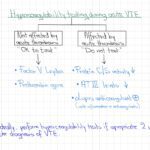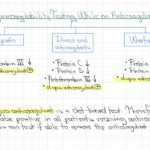
Several prognostic tools or scores are used in hematology clinical practice to risk-stratify individuals with lymphomas. These scores help us estimate the risk of death (overall survival or OS) and determine the best strategies to monitor and manage our patients. This post discusses these tools and provides easier ways to remember them. Although these methods can be found online and in applications such as MedCalc or Calculate, remembering these scores is helpful for daily clinical practice and can be tested in medical boards.
There are 3 main tools to remember:
- International Prognostic Index (IPI): Used for diffuse large B-cell lymphomas (DLBCL)
- Follicular Lymphoma International Prognostic Index (FL-IPI or FLIPI)
- Mantle Cell Lymphoma International Prognostic Index (M-IPI or MIPI)
Unfortunately, each of these indices is different, but they share several characteristics. I will review each one and provide the main similarities and differences at the end of the post.
International Prognostic Index (IPI) for Diffuse Large B-cell Lymphoma (DLBCL)
- Estimates the risk of death by providing an overall survival according to specific characteristics. Used for DLBCL but can be considered for high-grade B-cell lymphomas other than the 4 main groups mentioned above. For example, in large B-cell lymphomas.
- Mnemonic: To better understand a patient’s DLBCL, we need to take “An EExtra Step in Lymphomas.” Remember age, extranodular sites, ECOG of performance status, and LDH level as seen below.
- Interpretation: Scores are calculated and divided into very good, good, and poor risk (according to the data in the rituximab era). Since the use of rituximab is standard today, we will not cover the older interpretative table below.

Follicular Lymphoma International Prognostic Index (FL-IPI or FLIPI)
- Similar to IPI in DLBCL, it estimates the overall survival of patients with follicular lymphoma according to their stratification.
- FLIPI is quite similar to IPI. However, it differs in two aspects. First, extranodular involvement is changed for the number of nodal sites (cervical, axillary, mediastinal, paraaortic, mesenteric, and inguinal). Second, instead of performance status (ECOG), “FLIPI doesn’t care if you are flipping” (helps to remember that performance status here is not considered).
- Way to remember: “FLIPI doesn’t care if you are flipping, but does care if you fall and break into bleeding pieces.” If 4 or more nodal sites, that makes it higher risk. If you bleed, it is worse. Therefore, FLIPI also considers hemoglobin. This is silly, but it may work for you!
- There is a newer version of FLIPI called FLIPI2 (rituximab era) that can be used and incorporates data from B2-microglobulin and bone marrow involvement. However, FLIPI continues to be used more frequently in clinical practice.
FLIPI Score:
| Characteristic | 0 Points | 1 Point |
|---|---|---|
| Age | <60 | ≥60 |
| Stage (Ann Harbor) | I-II | III-IV |
| Nodal areas | ≤4 | >4 |
| LDH | Normal | Elevated |
| Hemoglobin | ≥12 | <12 |
Interpreation:
| FLIPI Score | Risk Group | 10 year OS % |
|---|---|---|
| 0-1 | Low | 70-80% |
| 2 | Intermediate | 50-60% |
| ≥3 | High | 35-40% |
Mantle Cell Lymphoma International Prognostic Index (MIPI)
- MIPI is the stratification tool used in patients with mantle cell lymphoma.
- Here, there are only four factors to evaluate instead of five: age, LDH, WBC count, and ECOG or performance status. Compared with IPI for DLBCL, age, LDH, and ECOG are also used, but the white blood cell count (WBC) is added.
- Mnemonic: “Mantle Eco With Lymphoma”
- Importantly, the MIPI score is more complicated to calculate since it requires input of specific numbers in the age, ECOG, LDH, and WBC counts. Therefore, the most relevant step here is to remember the criteria and use any calculator to estimate the score.
| Characteristic | |
| Age | Input actual age |
| ECOG Performance Status | 0-5 |
| LDH | Ratio to the upper limit of normal |
| WBC count | Number |
| Calculated MIPI Score | Risk Group | 5-year OS |
| ≤ 3 | Low | 60-70% |
| > 3 and ≤ 5.7 | Intermediate | 35-50% |
| > 5.7 | High | 20% |
There is a simplified version of the MIPI score that can be viewed as a table. However, it is not as helpful to memorize. Instead, I recommend using online tools or apps such as MDCalc to calculate the score. For boards, remembering the 4 criteria helps with a mental estimation of how aggressive the disease could be.

Differentiating Between the Three Scales:
| Characteristics | IPI | FLIPI | MIPI |
| Used in | DLBCL | Follicular lymphoma | Mantle cell lymphoma |
| Age | Yes | Yes | Yes |
| LDH | Yes | Yes | Yes |
| ECOG | Yes | No (“no flipping”) | Yes |
| Other Lab | No | Hemoglobin (flip and fall = bleed) | WBC (think of the “W” as an inverted “M”) |
| Stage or site of involvement | Ann Harbor stage | Nodal regions | No |
Rather than studying these scales separately, my recommendation is to study them together to help you understand their similarities and differences. It is interesting to think more deeply about why these differences may apply to one disorder versus another. For example, involvement of the bone marrow in follicular lymphoma suggests that the disease is more aggressive, as suggested by a lower hemoglobin level. However, in DLBCL, most patients have marrow involvement, and its usefulness for prognostication is not as relevant. Similarly, mantle cell leukemia can have a more “leukemic” presentation with many lymphocytes in the peripheral blood that may occur as frequently as with the other leukemias.
Finally, remember to use these scales as frequently as possible when assessing patients with these conditions and by studying them several times in the future using diverse tools such as tests, flashcards, question banks, and others.
We hope you enjoyed this post! Please leave us any comments or questions below. Feel free to rate our post using the star system below if your time allows. Your feedback is important to us. Thank you!




